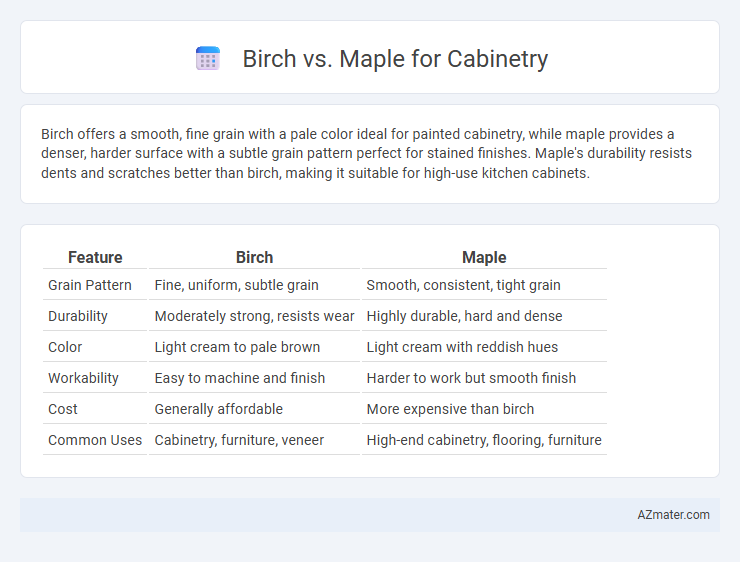Birch offers a smooth, fine grain with a pale color ideal for painted cabinetry, while maple provides a denser, harder surface with a subtle grain pattern perfect for stained finishes. Maple's durability resists dents and scratches better than birch, making it suitable for high-use kitchen cabinets.
Table of Comparison
| Feature | Birch | Maple |
|---|---|---|
| Grain Pattern | Fine, uniform, subtle grain | Smooth, consistent, tight grain |
| Durability | Moderately strong, resists wear | Highly durable, hard and dense |
| Color | Light cream to pale brown | Light cream with reddish hues |
| Workability | Easy to machine and finish | Harder to work but smooth finish |
| Cost | Generally affordable | More expensive than birch |
| Common Uses | Cabinetry, furniture, veneer | High-end cabinetry, flooring, furniture |
Birch vs Maple for Cabinetry: An Overview
Birch and maple are popular woods for cabinetry, each offering unique characteristics suited for different styles and budgets. Birch features a fine, even grain with a pale color that takes stains well, making it versatile for various finishes, while maple is known for its durability, smooth texture, and subtle grain patterns that provide a clean, modern look. Maple tends to be harder and more resistant to dents and scratches compared to birch, making it a practical choice for high-traffic kitchen environments.
Appearance and Grain Patterns
Birch cabinetry features a smooth, fine grain with subtle variations and a light, creamy tone that can range from pale yellow to reddish-brown, offering a clean and uniform appearance. Maple boasts a tighter, denser grain with a consistent, light color that varies from nearly white to a warm, reddish hue, producing a sleek and modern look. Both woods take stains well, but birch's pronounced grain patterns provide more visual texture compared to maple's more subdued and even grain.
Strength and Durability Comparison
Birch offers a fine grain and exceptional hardness, making it highly resistant to dents and scratches, which enhances its durability for cabinetry. Maple is renowned for its superior density and strength, providing excellent resistance to wear and impact, ideal for high-traffic kitchen cabinets. Both hardwoods deliver strong, long-lasting performance, though maple often edges out birch in overall toughness and longevity.
Cost Differences Between Birch and Maple
Birch cabinetry generally costs less than maple due to its faster growth rate and more abundant supply, making it a budget-friendly option for homeowners. Maple wood, known for its durability and fine grain, commands higher prices because of its density and slower growth, which increases harvesting time and processing costs. Choosing birch can reduce upfront cabinetry expenses by up to 20-30% compared to maple, while still offering a strong and attractive wood option.
Workability and Finishing
Birch offers excellent workability due to its fine, even grain, making it easier to machine and shape compared to Maple, which is harder and denser. Maple's tight grain provides a smooth surface that finishes beautifully but requires sharper tools and more effort to avoid tear-out. Both woods accept stains and finishes well, but Birch's uniform texture delivers more consistent color absorption, enhancing cabinet aesthetics.
Staining and Painting Results
Birch wood provides a smooth, uniform grain that accepts stain evenly, resulting in a rich, consistent finish ideal for enhancing natural wood tones in cabinetry. Maple, with its dense, tight grain, can be more challenging to stain as it tends to blotch without proper pre-treatment, but its fine texture offers excellent results when painted, creating a sleek, durable surface. For cabinetry projects prioritizing staining, birch offers predictable, high-quality outcomes, while maple is preferred for vibrant, long-lasting painted finishes.
Environmental Impact and Sustainability
Birch cabinetry offers moderate environmental benefits due to its fast growth rates and widespread availability, which supports sustainable forestry practices. Maple, although slower-growing, is prized for its durability and long lifespan, reducing the need for frequent replacements and lowering overall environmental impact. Choosing certified wood from responsibly managed sources ensures both birch and maple remain eco-friendly options for sustainable cabinetry.
Maintenance and Longevity
Birch cabinets offer moderate durability with a smooth surface that resists dents and scratches, requiring regular cleaning and occasional refinishing to maintain their appearance. Maple cabinets are harder and denser, providing superior resistance to wear and tear, which reduces the frequency of maintenance and prolongs their lifespan significantly. Both woods benefit from sealed finishes to protect against moisture and staining, but maple's natural hardness typically ensures longer-lasting cabinetry in high-traffic kitchen environments.
Best Uses for Each Wood Type
Birch wood is ideal for cabinetry requiring a smooth, fine grain that accepts paint and stains evenly, making it perfect for contemporary or traditional kitchen designs. Maple offers superior hardness and durability, which suits high-traffic areas and cabinetry that benefits from a natural, light-toned finish showcasing subtle grain patterns. Choosing birch enhances intricate detailing and uniform color, while maple excels in strength and resistance to dents for long-lasting cabinet performance.
Choosing Between Birch and Maple for Your Cabinets
Birch offers a fine grain with a light, warm tone that stains well, making it ideal for achieving a varied range of finishes in cabinetry. Maple features a smooth, dense texture with a subtle grain pattern and is favored for its durability and resistance to dents and scratches. When choosing between birch and maple for cabinets, consider birch for budget-friendly customization and maple for a robust, long-lasting surface.

Infographic: Birch vs Maple for Cabinetry
 azmater.com
azmater.com